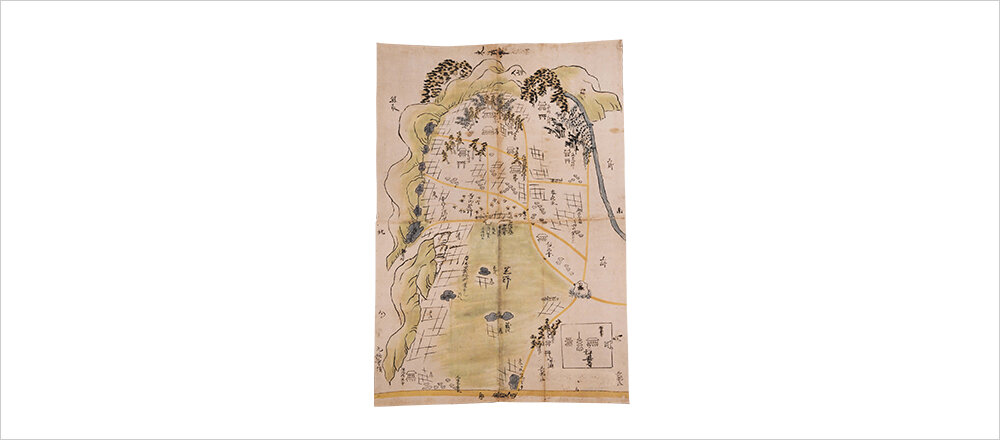Painting of Wilderness Cultivation in Hineno Village, Hinenosho, Izumi Province
A painting created in 1316 depicting Hineno Village in the estate of the Kujo family. One of the sources of the story of Hinenosho, it shows a lush, green landscape with shrines, temples, and other buildings.

This painting of the area around the Hinenosho manor was passed down in the Kujo family archives. Writing on the back reveals that it was created in 1316.
Hinenosho was built in 1234. At that time, Hinenosho’s Hineno Village and Ihara Village were vast wildernesses, and the cultivation of these and their water resources was of the utmost importance for the Kujo family, the lords of the manor. Following a failed cultivation attempt in 1310, the Kujo family contracted Kumedadera Temple to conduct the development in 1315. It is believed that this painting was made at that time.
Locations depicted in the painting that still exist today include “Oiseki Daimyojin” (now Hine Jinja Shrine), “Mizoguchi Daimyojin” (merged into Hine Jinja Shrine), “Niu Daimyojin” (merged into Nonomiya, later Hine Jinja Shrine), “Ushigamimatsu” (now Shindode Ushigami Altar), “Anatoshi” (now Aritoshi Jinja Shrine, location later changed), “Jujitaniike” (now Junidaniike Pond), “Yaeike Pond” (now Yaejiike Pond), and “Amazukeike” (now Amazuike Pond). In addition, based on its location, “Zenrinji” is believed to be today’s Sofukuji Temple.
Two buildings in the painting, “Muhen Koin” (which, according to one theory, is today’s Jigen-in Temple) and “Zenkoji” are depicted in greater detail than the others. It is thought that this is because the Zenkoji temple served as the government office at the time of Hinenosho’s establishment and that the Muhen Koin temple was the government office at the time of the painting’s creation. The Muhen Koin temple was also the family temple of Minamoto no Kanesada, who was the de facto lord of Hinenosho at the time. In addition, records from that time state that the Muhen Koin temple’s gate had been destroyed and that only the stone building remained, yet its main gate is deliberately depicted, creating a contrived air.
Also of note, given the water resources shown, it is thought that it would be difficult to cultivate the entirety of the rice fields in the upper part of the painting, and it is suspected that a waterway that later developed into the Yukawa Watercourse may have existed.






